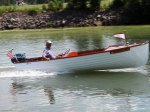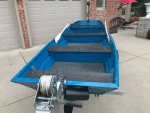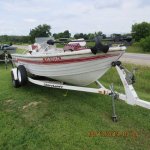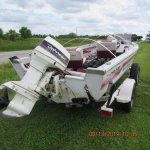First off, this is concerning flat-bottom-hull and v-hull jon boats, utilizing 15HP outboard. Because of 15HP, most would be starting at 14ft and up. Also, for this discussion, will look at one-man driven boat, meaning one person, sitting at the back using a tiller 15HP (and possible battery in back). Now, plane a boat is after takeoff and is fully driven at cruising speed, nothing about displacement or plowing mode.
Generally, at the back of v-hull boats are simply pretty flat, with little rounded edges. Flat-bottom-hull usually straight flat, with sharp cornered edges. Both transom are flat backed. Both have fin strips on bottom (is that correct terminology).
When I watch YouTube, I see boats on planning mode. To me, v-hull front section is completely off the water. Even when maneuver turns and back to straight, the v-hull still off the water. In a sense, v-hull boats can slap on waves. So, what does a v-hull do during planing?
I am trying to see what explanations are saying about v-hull handles rough water better and ability to cut through waves. Again, this is concerning ~14ft jon boats with 15HP, not yachts (meaning yachts' v-hull remains in water, even at cruising speeds). I didn't pay attention to larger bass boats on how they plane (I notice larger bass boats have v-hull covering more than half of whole bottom hull). We can bring modified hulls into this discussion.
Please correct me is I said anything wrong or misinterpreted anything in here. I am asking questions. Thank you.
Generally, at the back of v-hull boats are simply pretty flat, with little rounded edges. Flat-bottom-hull usually straight flat, with sharp cornered edges. Both transom are flat backed. Both have fin strips on bottom (is that correct terminology).
When I watch YouTube, I see boats on planning mode. To me, v-hull front section is completely off the water. Even when maneuver turns and back to straight, the v-hull still off the water. In a sense, v-hull boats can slap on waves. So, what does a v-hull do during planing?
I am trying to see what explanations are saying about v-hull handles rough water better and ability to cut through waves. Again, this is concerning ~14ft jon boats with 15HP, not yachts (meaning yachts' v-hull remains in water, even at cruising speeds). I didn't pay attention to larger bass boats on how they plane (I notice larger bass boats have v-hull covering more than half of whole bottom hull). We can bring modified hulls into this discussion.
Please correct me is I said anything wrong or misinterpreted anything in here. I am asking questions. Thank you.



























